
Liberia is a country in West Africa founded by free people of color from the United States. The emigration of African Americans, both free and recently emancipated, was funded and organized by the American Colonization Society (ACS). The mortality rate of these settlers was the highest among settlements reported with modern recordkeeping. Of the 4,571 emigrants who arrived in Liberia between 1820 and 1843, only 1,819 survived (39.8%).

The Armed Forces of Liberia (AFL) are the armed forces of the Republic of Liberia. Tracing its origins to a militia that was formed by the first black colonists in what is now Liberia, it was founded as the Liberian Frontier Force in 1908, and retitled in 1956. For almost all of its history, the AFL has received considerable materiel and training assistance from the United States. For most of the 1941–89 period, training was largely provided by U.S. advisers, though this assistance has not prevented the same generally low levels of effectiveness common to most of the armed forces in the developing world.
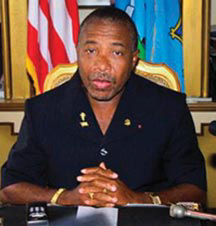
Charles McArthur Ghankay Taylor is a Liberian former politician and convicted war criminal who served as the 22nd president of Liberia from 2 August 1997 until his resignation on 11 August 2003 as a result of the Second Liberian Civil War and growing international pressure.
Prince Yormie Johnson is a Liberian politician and the current Senior Senator from Nimba County. A former rebel leader, Johnson played a prominent role in the First Liberian Civil War. Serving as leader of the Independent National Patriotic Front of Liberia, he captured, tortured and executed President Samuel Doe, who had himself overthrown and murdered the previous president William R. Tolbert Jr.
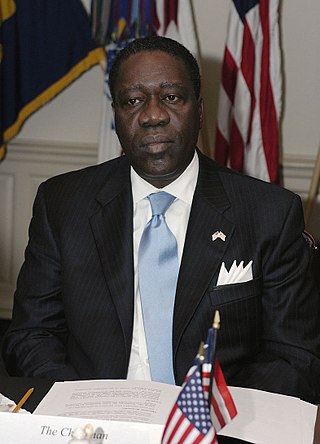
Charles Gyude Bryant was a Liberian politician and businessman. He served as the Chairman of the Transitional Government of Liberia from 14 October 2003 to 16 January 2006. The installation of the transitional government was part of the peace agreement to end the country's second civil war, which had raged since the Liberians United for Reconciliation and Democracy (LURD) rebelled against President Charles Taylor in 1999. Bryant was previously a businessman and was chosen as chairman because he was seen as politically neutral and therefore acceptable to each of the warring factions, which included LURD, the Movement for Democracy in Liberia (MODEL), and loyalists of former President Taylor. He was a prominent member of the Episcopal Church of Liberia, and was critical of the governments of Samuel Doe (1980–90) and Taylor (1997–2003).

The Liberians United for Reconciliation and Democracy (LURD) was a rebel group in Liberia that was active from 1999 until the resignation of Charles Taylor ended the Second Liberian Civil War in 2003. While the group formally dissolved after the war, the interpersonal linkages of the civil war era remain a key force in internal Liberian politics.
The Movement for Democracy in Liberia (MODEL) was a rebel group in Liberia that became active in March 2003, launching attacks from Ivory Coast. MODEL was based on the Force Spéciale pour la Libération du Monde Africain (LIMA) militia formed in September 2002 to defend Laurent Gbagbo's government against insurgents backed by Liberia's president Charles Taylor. After fighting off the imminent threat, parts of LIMA crossed the border to Liberia to continue the war there. With Taylor's forces already pressed against the larger Liberians United for Reconciliation and Democracy (LURD), MODEL quickly gained ground. The initial leadership of MODEL came from LURD, while the majority of MODEL fighters were mobilized from Ivorian and Ghanaian refugee camps, to which many Liberians from the country's Southeast had fled.

The First Liberian Civil War was the first in a series of two civil wars within the West African nation of Liberia. It lasted from 1989 to 1997. President Samuel Doe had established a regime in 1980 but totalitarianism and corruption led to unpopularity and the withdrawal of support from the United States by the late 1980s. The National Patriotic Front of Liberia (NPFL) led by Charles Taylor invaded Liberia from the Ivory Coast to overthrow Doe in December 1989 and gained control over most of the country within a year. Doe was captured and executed by the Independent National Patriotic Front of Liberia (INPFL), a splinter faction of the NPFL led by Prince Johnson, in September 1990. The NPFL and INPFL fought each other for control of the capital city, Monrovia and against the Armed Forces of Liberia and pro-Doe United Liberation Movement of Liberia for Democracy. Peace negotiations and foreign involvement led to a ceasefire in 1995 but fighting continued until a peace agreement between the main factions occurred in August 1996. Taylor was elected President of Liberia following the 1997 Liberian general election and entered office in August of the same year.
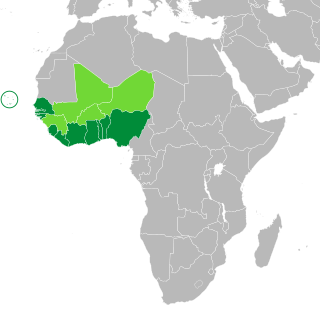
The Economic Community of West African States Monitoring Group (ECOMOG) was a West African multilateral armed force established by the Economic Community of West African States (ECOWAS). ECOMOG was a formal arrangement for separate armies to work together. It was largely supported by personnel and resources of the Nigerian Armed Forces, with sub-battalion strength units contributed by other ECOWAS members — Ghana, Guinea, Sierra Leone, The Gambia, Liberia, Mali, Burkina Faso, Niger, and others.
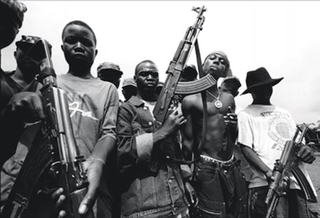
The Second Liberian Civil War was a civil war in the West African nation of Liberia that lasted from 1999 to 2003.
David Roosevelt Johnson was a Liberian who led a rebel group during the country's civil war. He was not a member of the Krahn ethnic group he fought for; however, his wife was Krahn.
Sekou Damate Conneh, Jr. is a Liberian politician and former rebel leader.

The United Nations Mission in Liberia (UNMIL) was a peacekeeping operation established in September 2003 to monitor a ceasefire agreement in Liberia following the resignation of President Charles Taylor and the conclusion of the Second Liberian Civil War (1999–2003). At its peak it consisted of up to 15,000 U.N. military personnel and 1,115 police officers, along with civilian political advisors and aid workers.

The National Transitional Legislative Assembly (NTLA) was Liberia's legislative body during the country's transition from civil war to democratic rule.
A new civil war began in 1999 when a rebel group backed by the government of neighboring Guinea, the Liberians United for Reconciliation and Democracy (LURD), emerged in northern Liberia. By the spring of 2001, they were posing a major threat to the Taylor government. Liberia was now engaged in a complex three-way conflict with Sierra Leone and the Guinea Republic. By the beginning of 2002, both of these countries were supporting the latest addition to the lexicon of Liberian guerrilla outfits – Liberians United for Reconciliation and Democracy (LURD), while Taylor was supporting various opposition factions in both countries. By supporting Sierra Leonean rebels, Taylor also drew the enmity of the British and Americans.

Liberia – United States relations are bilateral relations between Liberia and the United States.
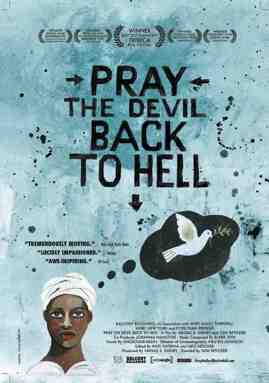
Pray the Devil Back to Hell is a 2008 American documentary film directed by Gini Reticker and produced by Abigail Disney. The film premiered at the 2008 Tribeca Film Festival, where it won the award for Best Documentary. The film had its theatrical release in New York City on November 7, 2008. It had cumulative gross worldwide of $90,066.

Women of Liberia Mass Action for Peace is a peace movement started in 2003 by women in Monrovia, Liberia, Africa, that worked to end the Second Liberian Civil War. Organized by Crystal Roh Gawding and social workers Leymah Gbowee and Comfort Freeman, the movement began despite Liberia having extremely limited civil rights. Thousands of Muslim and Christian women from various classes mobilized their efforts, staged silent nonviolence protests that included a sex strike and the threat of a curse.
The Accra Comprehensive Peace Agreement or Accra Peace Agreement was the final peace agreement in the Second Liberian Civil War. It was signed on 18 August 2003 in Accra, Ghana. It was created following the signing of a ceasefire agreement on 17 June 2003 and "intensive back-door negotiations" beginning on 4 June in Akosombo, Ghana.
The Booker Washington Institute (BWI) is a public, post-secondary school in Kakata, Margibi County, Liberia. Founded in 1929 as the Booker Washington Agricultural and Industrial Institute, it was the country's first agricultural and vocational school. BWI was founded with assistance from Americans and is named after American educator Booker T. Washington. Located east of the country's capital of Monrovia, the school sits on a large rural campus and has about 1,800 students.












